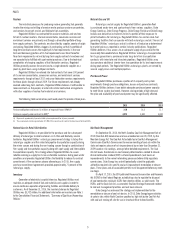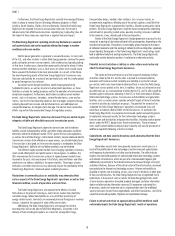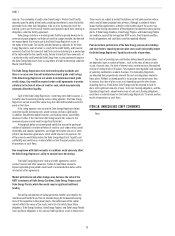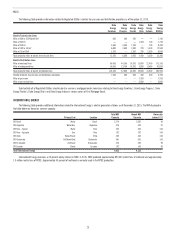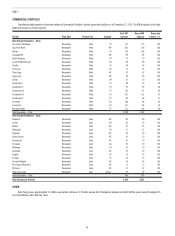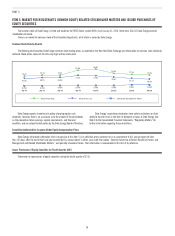Duke Energy 2015 Annual Report Download - page 37
Download and view the complete annual report
Please find page 37 of the 2015 Duke Energy annual report below. You can navigate through the pages in the report by either clicking on the pages listed below, or by using the keyword search tool below to find specific information within the annual report.
PART I
17
respectively, and periods of low rainfall that decrease the ability to
operate facilities in an economical manner;
• supply of and demand for energy commodities;
• transmission or transportation constraints or inefficiencies that impact
nonregulated energy operations;
• availability of competitively priced alternative energy sources, which
are preferred by some customers over electricity produced from
coal, nuclear or gas plants, and customer usage of energy efficient
equipment that reduces energy demand;
• natural gas, crude oil and refined products production levels and prices;
• ability to procure satisfactory levels of inventory, such as coal, gas and
uranium; and
• capacity and transmission service into, or out of, the Duke Energy
Registrants’ markets.
Natural disasters or operational accidents may adversely affect the Duke
Energy Registrants’ operating results.
Natural disasters (such as electromagnetic events or the 2011 earthquake
and tsunami in Japan) or other operational accidents within the company or
industry (such as the San Bruno, California natural gas transmission pipeline
failure) could have direct significant impacts on the Duke Energy Registrants as
well as on key contractors and suppliers. Such events could indirectly impact
the Duke Energy Registrants through changes to policies, laws and regulations
whose compliance costs have a significant impact on the Duke Energy
Registrants’ financial position, results of operations and cash flows.
The reputation and financial condition of the Duke Energy Registrants
could be negatively impacted due to their obligations to comply with
federal and state regulations, laws, and other legal requirements that
govern the operations, assessments, storage, closure, remediation,
disposal, and monitoring relating to coal combustion residuals (CCR), the
high costs and new rate impacts associated with implementing these new
CCR-related requirements, and the strategies and methods necessary to
implement these requirements in compliance with these legal obligations.
As a result of electricity produced for decades at coal-fired power plants,
the Duke Energy Registrants manage large amounts of CCR that are primarily
stored in dry storage within landfills or combined with water in other surface
impoundments, all in compliance with applicable regulatory requirements.
However, the potential exists for another CCR-related incident, such as the one
that occurred during the 2014 Dan River Steam Station basin release, that could
raise environmental or general public health concerns. Such a CCR-related
incident could have a material adverse impact on the reputation and financial
condition of the Duke Energy Registrants.
During 2015, EPA regulations were enacted related to the management
of CCR from power plants. These regulations classify CCR as nonhazardous
waste under the RCRA, and apply to electric generating sites with new and
existing landfills, new and existing surface impoundments, structural fills
and CCR piles, and establishes requirements regarding landfill design,
structural integrity design and assessment criteria for surface impoundments,
groundwater monitoring and protection procedures, and other operational and
reporting procedures for the disposal and management of CCR. In addition to
the federal regulations, CCR landfills and surface impoundments will continue to
be independently regulated by existing state laws, regulations, and permits, as
well as additional legal requirements that may be imposed in the future. These
federal and state laws, regulations, and other legal requirements may require
or result in additional expenditures, increased operating and maintenance
costs, and/or result in closure of certain power generating facilities, which
could affect the financial position, results of operations and cash flows of the
Duke Energy Registrants. The Duke Energy Registrants intend to seek full cost
recovery for expenditures through the normal ratemaking process with state
and federal utility commissions, who permit recovery in rates of necessary and
prudently incurred costs associated with the Duke Energy Registrants’ regulated
operations, and through other wholesale contracts with terms that contemplate
recovery of such costs, although there is no guarantee of full cost recovery. In
addition, the timing for recovery of such costs could have a material adverse
impact on Duke Energy’s cash flows.
The Duke Energy Registrants have recognized significant asset retirement
obligations related to these CCR-related requirements. In 2015, closure
activities began at the four sites specified as high priority by the North Carolina
Coal Ash Management Act (Coal Ash Act) and at the W.S. Lee Steam Station
site in South Carolina in connection with other legal requirements. Excavation
at these sites involves movement of large amounts of CCR materials to off-site
locations for use as structural fill and to off-site or on-site lined landfills.
At other sites, preliminary planning and closure methods have been studied
and factored into the estimated retirement and management costs. Coal
Ash Act requires CCR surface impoundments in North Carolina to be closed,
with the closure method based on a risk ranking classification determined by
state regulators and the North Carolina Coal Ash Commission. Other than the
high priority sites specifically delineated by Coal Ash Act, the North Carolina
Department of Environmental Quality (NCDEQ) has issued either preliminary
draft risk rankings or has yet to designate specific risk classifications. These
proposed risk rankings remain subject to a public comment period, including
public meetings, followed by a final risk ranking recommendation by the NCDEQ
to the Coal Ash Commission, for the Coal Ash Commission’s final approval.
As the closure and CCR management work progresses, final risk ranking
classifications of surface impoundments in North Carolina are delineated,
and final closure plans are developed and approved at each site, the scope
and complexity of work and the amount of CCR material could be greater than
estimates and could, therefore, materially increase compliance expenditures
and rate impacts.
The Duke Energy Registrants’ financial position, results of operations and
cash flows may be negatively affected by a lack of growth or slower growth
in the number of customers, or decline in customer demand or number of
customers.
Growth in customer accounts and growth of customer usage each directly
influence demand for electricity and the need for additional power generation
and delivery facilities. Customer growth and customer usage are affected by
a number of factors outside the control of the Duke Energy Registrants, such
as mandated energy efficiency measures, demand-side management goals,
distributed generation resources and economic and demographic conditions,
such as population changes, job and income growth, housing starts, new
business formation and the overall level of economic activity.
Certain regulatory and legislative bodies have introduced or are
considering requirements and/or incentives to reduce energy consumption
by certain dates. Additionally, technological advances driven by federal laws
mandating new levels of energy efficiency in end-use electric devices or other
improvements in or applications of technology could lead to declines in per
capita energy consumption.
Advances in distributed generation technologies that produce power,
including fuel cells, micro-turbines, wind turbines and solar cells, may reduce
the cost of alternative methods of producing power to a level competitive with
central power station electric production utilized by the Duke Energy Registrants.
Some or all of these factors, could result in a lack of growth or decline in
customer demand for electricity or number of customers, and may cause the
failure of the Duke Energy Registrants to fully realize anticipated benefits from
significant capital investments and expenditures which could have a material
adverse effect on their financial position, results of operations and cash flows.




